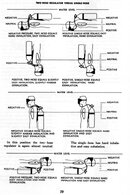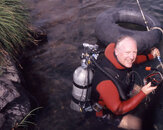The modified Trieste is not a bad option as a starter DH regulator, but it does have some trade-off.
Here is a link to the can conversion.
http://www.thescubamuseum.com/products/FX trieste titan precut cans.htm
If you do a search for the Pegasus project in VintageDoubleHose, you will see some write ups I did when I was developing the conversion of the Voit Titan single hose into a double hose regulator (the Titan has the same body as the Trieste). The Trieste was already a double hose regulator, so the only conversion was changing the can to get the mechanical advantage of the large diaphragm.
The final regulator ends up as a reasonable good performing regulator. No real compromise when it comes to performance.
The two compromises are the LP (and a bit of interference with the HP port) and at the time for service the first stage balancing chamber is a bit of an issue. Both of these issues have solutions. Some of the solutions are more elegant than others.
Both the LP and HP ports are on the right side and are fairly close to each other. Having the SPG on the right side is not the modern standard, but getting used to it is not a big deal. A bigger issue is that you only have one standard LP port and there is not enough space for most multi-port adapters.
There is a large LP port on the left side that could be used for an LP inflator, but it would require an adapter that is almost impossible to find or have one machined. I have a friend that has made a few of them.
I can send you some pictures of some of the LP port solutions from some of my Pegasus prototypes.
The solutions for the first stage service parts are probably not a concern for a few years. We can come back to that later.
I like the enthusiasm that you have for DH. But be aware that DH are a bit different.
Ideally to get started with a DH is to try it with someone that can show you how to use it. It is not hard, but some new divers may get frustrated early due to the differences. If you are near Vancouver, we have a good friend who is a very good DH diver and vintage scuba collector that maybe could help you, but I guess traveling is not an option at this moment.
If you are going to try it on your own, you want to read a lot and spend some time in a pool getting used to it and playing with it.





